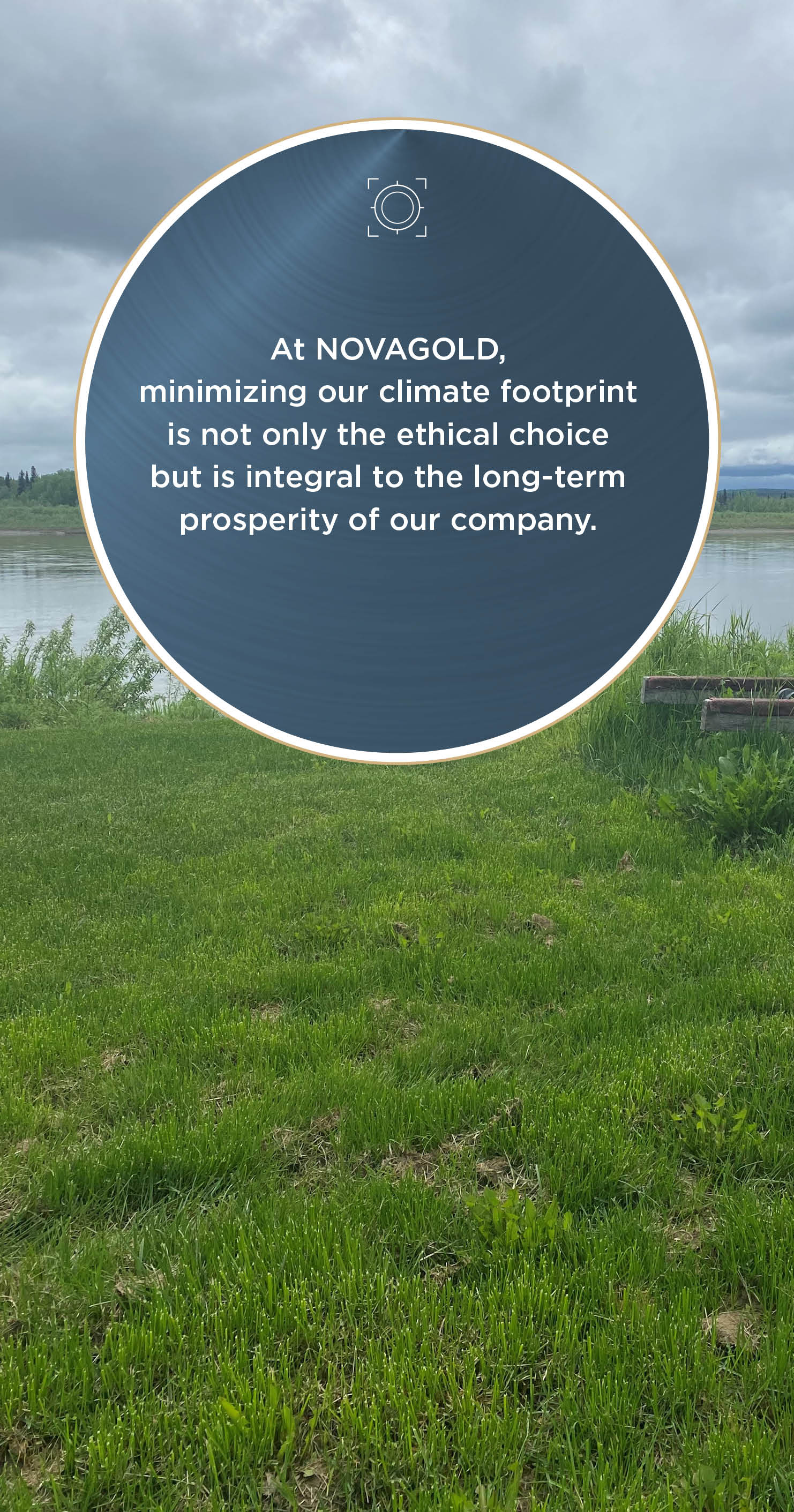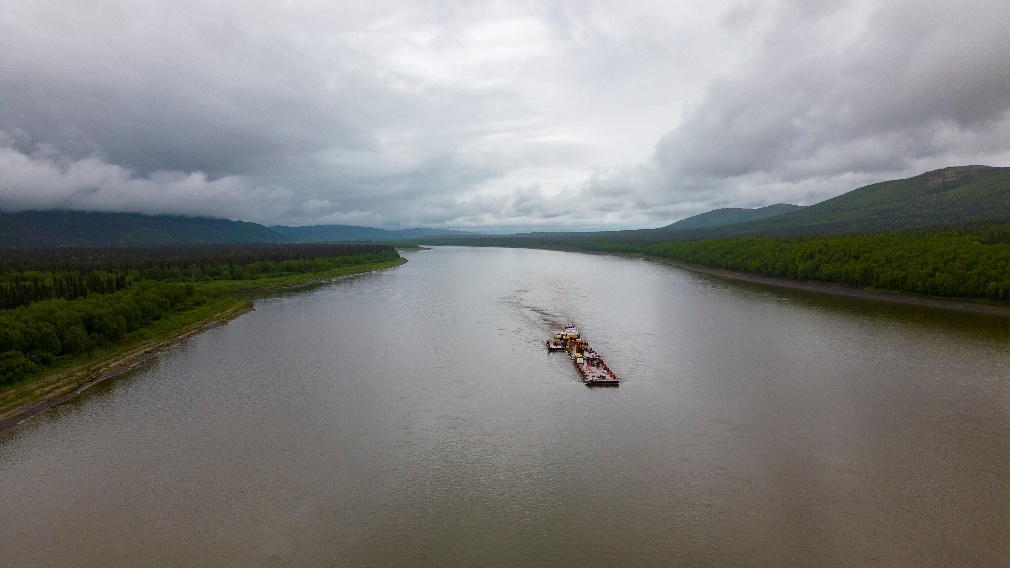Climate Change
At NOVAGOLD, minimizing our climate footprint is not only the ethical choice but is integral to the long-term prosperity of our company. NOVAGOLD is in the process of defining our overall objective(s) in relation to energy and GHG emissions but our view is that the most impactful targets are those set for its future operations, due to their very nature requiring far more energy (and potentially producing more GHG emissions). In line with the Paris Agreement, commitments made by industry bodies such as the ICMM (International Council on Mining and Metals), and commitments made by Donlin Gold’s co-owner, Barrick, NOVAGOLD’s long-term climate ambition is to strive to achieve Net Zero Carbon Emissions by 2050. NOVAGOLD expects all operations to adhere to the ambition of Net Zero Carbon Emissions by 2050; and to work toward setting short- and medium-term goals to achieve this aspiration. Therefore, NOVAGOLD commits to working closely with all subsidiaries and partnerships to ensure this is possible, and priority has been given to this action as opposed to internal company target setting. Overall, the intention is to mitigate threats to all assets and minimize any negative impacts our activities may have on the environment. More information on targets and commitments can be found specifically in our Climate Change Policy.
In 2023, NOVAGOLD began reporting climate change information in line with recommendations from TCFD. From this point onwards, TCFD shall be an integrated part of our sustainability reports; recommended disclosures are integrated throughout the report, and a TCFD index highlights where pertinent information can be found.
While climate change risks are included in our corporate risk register and are considered in all risk workshops and register updates, NOVAGOLD holds specific climate change risk management workshops to ensure that adequate time and attention is allocated to the consideration of climate change risks and opportunities, and to ensure that requirements of TCFD are met. NOVAGOLD recognizes its obligation to stakeholders to assess, manage, and, when possible, mitigate the potential impacts of climate change on our operations. Our commitment extends to considering biodiversity, deforestation, and reclamation in our planning and management activities. When considering risks, direct operations and upstream processes are considered. No product is produced yet, so while market considerations are included, the downstream profile created is limited.
As per recommendations from TCFD, risks related to climate change can be categorized as Transition Risks (both threats and opportunities which are associated with transitioning to a low-carbon economy, including risks related to Market, Technology, and Policy and Legal changes, in addition to changes to Reputation) and Physical Risks (both threats and opportunities which are associated with the physical impacts of climate change). Physical risks are then further categorized into acute (short-term but high impact risks such as storms or forest fires) or chronic (those which are gradual and prolonged). A number of transition and physical risks have been identified as having potentially significant impacts across the different scenarios and can be viewed in the full sustainability report here.
Several techniques have been utilized in the development of our climate change strategy in addition to risk identification exercises, including desktop studies and information gathering, data collection and quantitative analysis, and live interactive workshops. Short-, medium- and long-term impacts through to 2050 are considered through scenario analysis to assess risks. The scenarios used in NOVAGOLD’s analysis were developed by the Network for Greening the Financial System (NGFS), recommended by TCFD. NGFS scenarios identify a range of plausible futures to provide a common reference point, illustrating how physical and transition risks could develop in different future scenarios from the present day through to 2050 and beyond. In each scenario, and at every time interval, additional risks are added as appropriate.
As per the scenario descriptions below, risk profiles developed for NOVAGOLD across the scenarios show:
- Orderly – Net Zero 2050 has the highest transition risks, especially regarding emerging regulation and shareholder / investor expectation.
- Disorderly also has high transition risks, as well as physical risks becoming more prominent.
- The Hot House Current Policies scenario has the risk profile containing the most impactful physical risks. Reputation risks were also ranked highly with respect to impact, due to the potential for the perception being that any changes are due to activity by Donlin Gold.
| Name | Descriptions |
|---|---|
| Hot House Current Policies | The world implements policies it has agreed to by law, resulting in warming of 4-6 degrees Celsius. Lower transition risks are likely, with e.g., carbon prices remaining low or rarely introduced. High physical risks, with extreme weather events; extreme drought; sea level rise; and serious disruption of supply chains. |
| Disorderly - Delayed | The global response to climate change is slow until 2030, when e.g., extreme weather events, drought etc. become a certainty, initiating rapid policy and significant transition risk. Carbon pricing imposed rapidly at very high levels. Insurance and litigation also pose a particularly high risk. |
| Orderly – Net Zero 2050 | All countries work together coherently toward a ‘Net Zero’ carbon economy, resulting in a smaller temperature rise of approximately 1.5 degrees; physical risks are kept limited. Global economies experience transition risks such as high carbon prices; border adjustment; litigation; insurance; and investor sentiment. |


